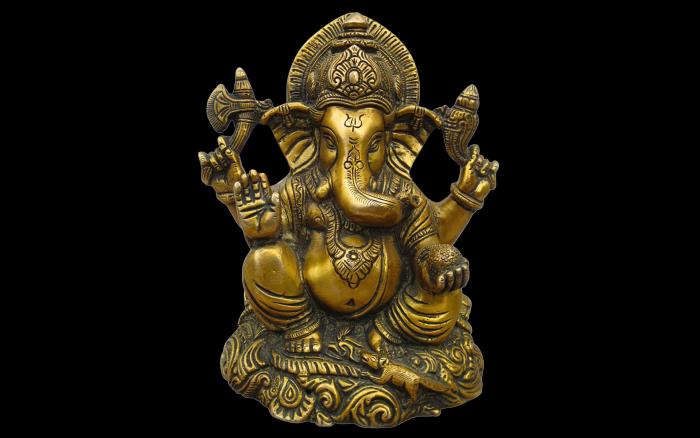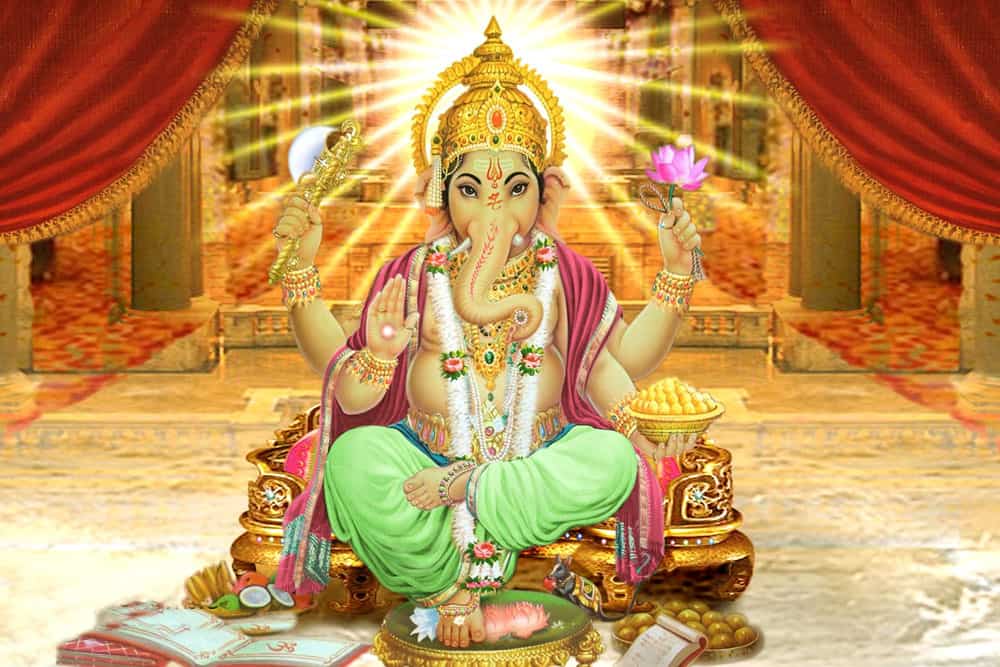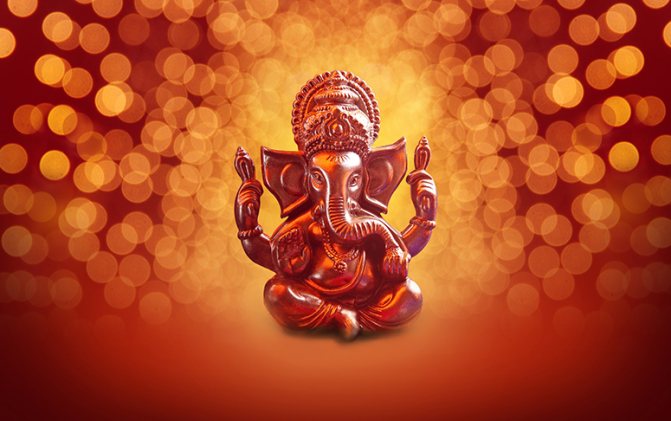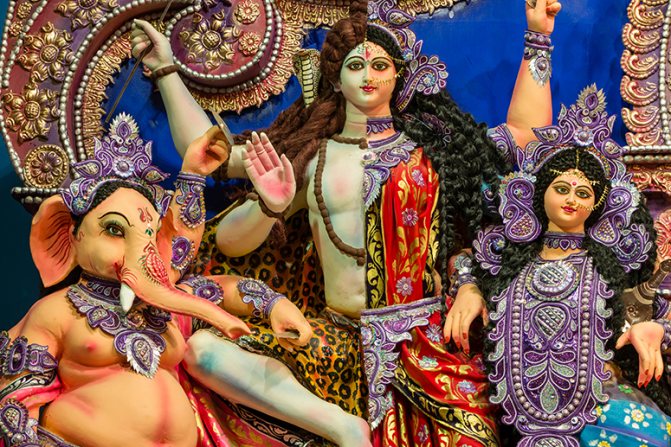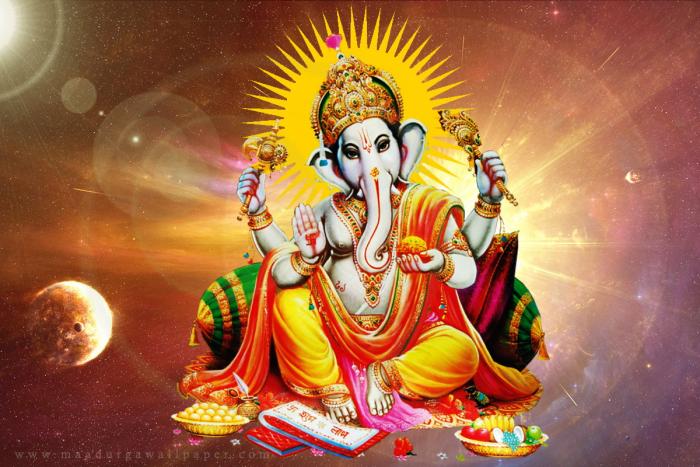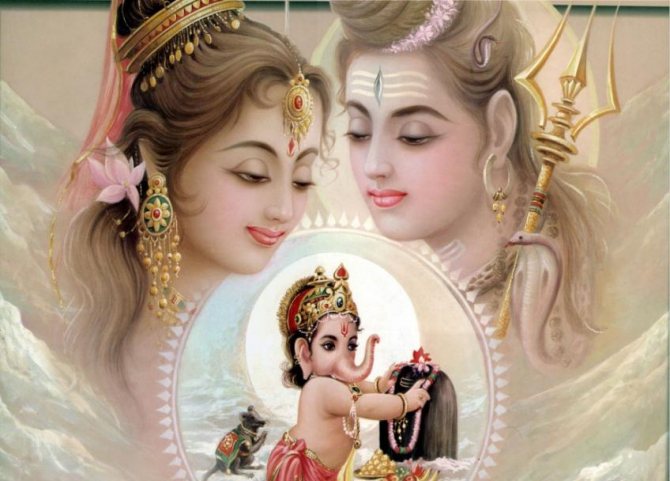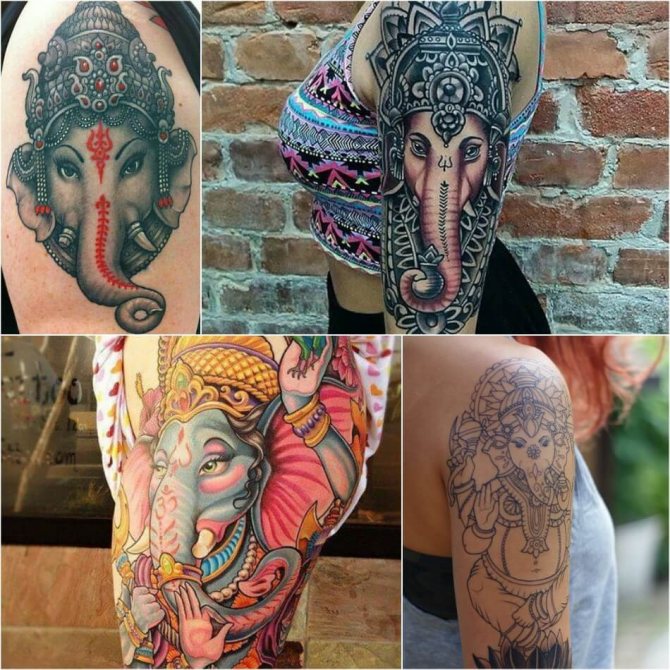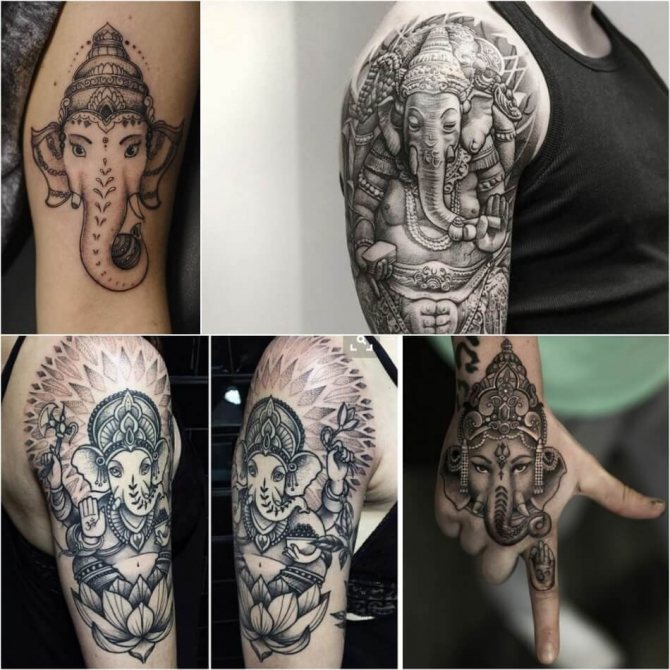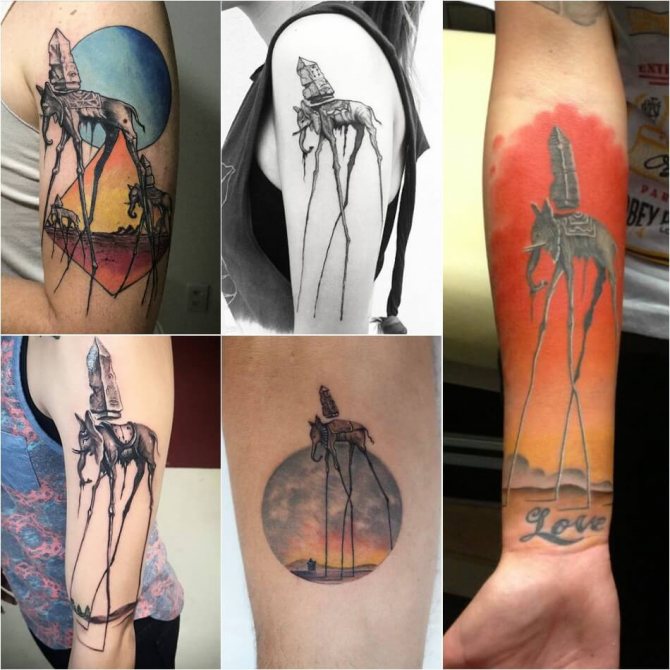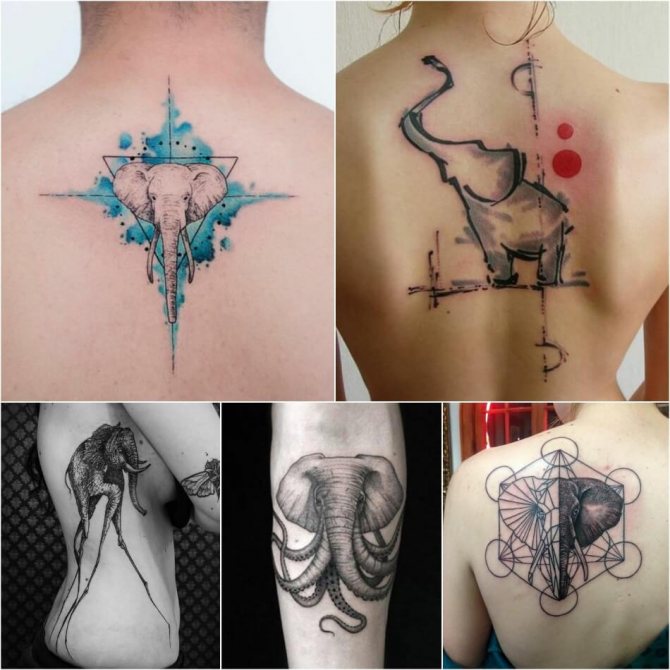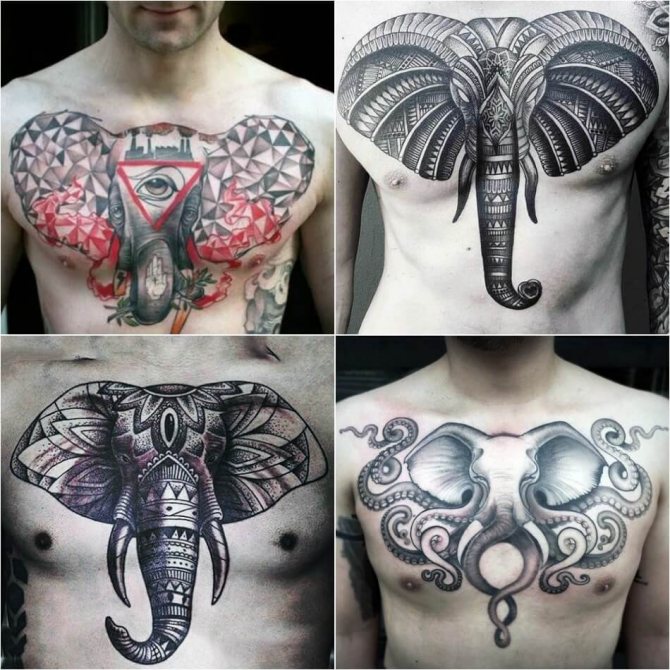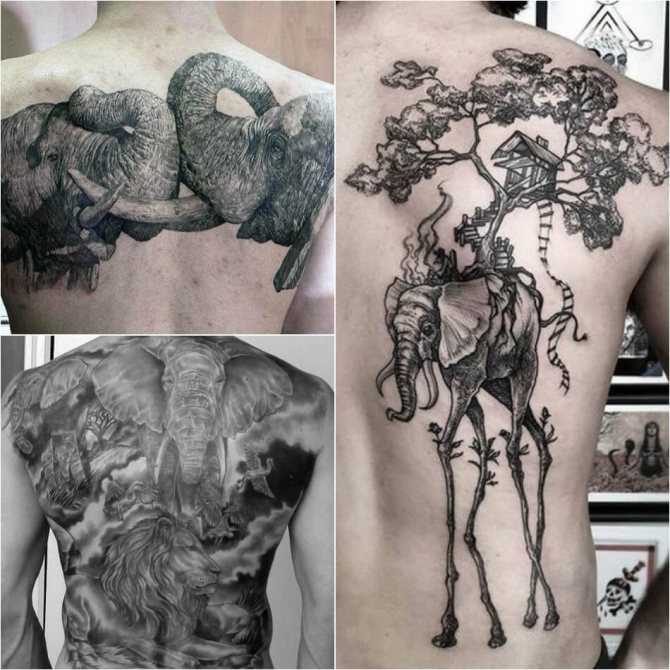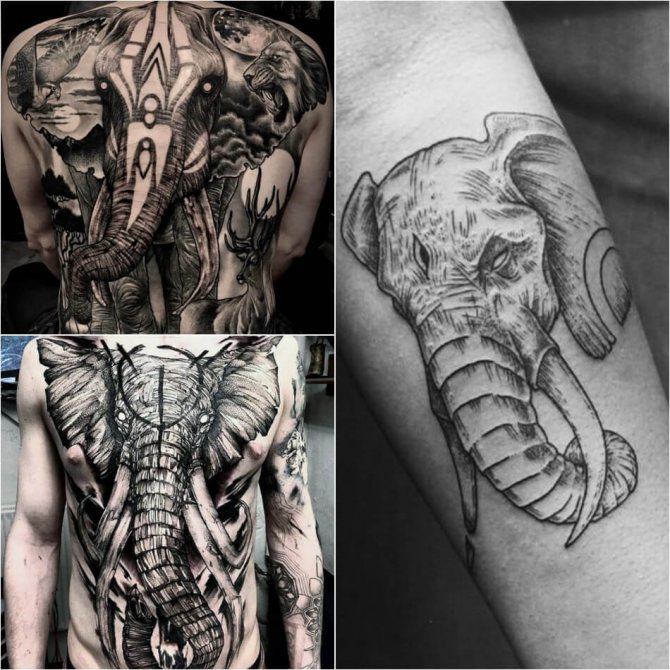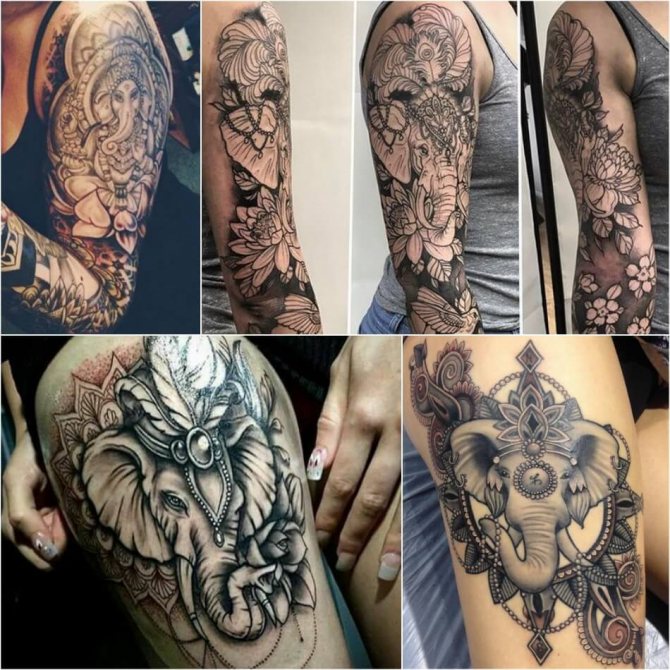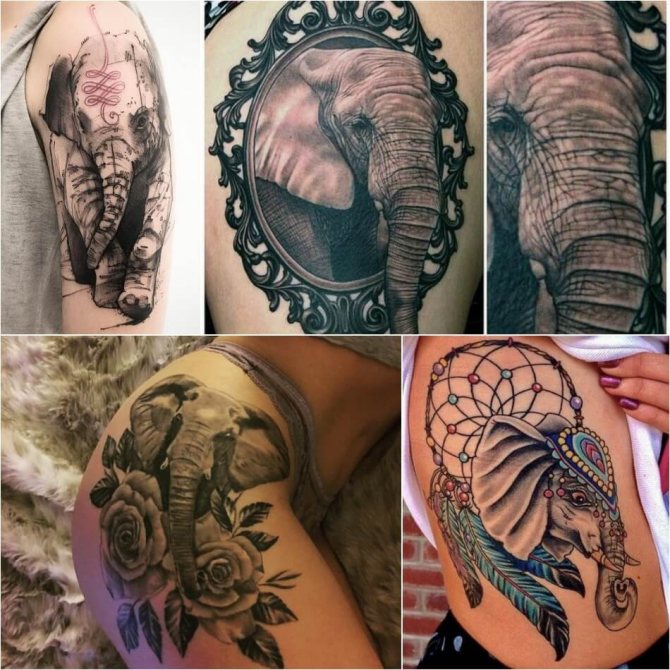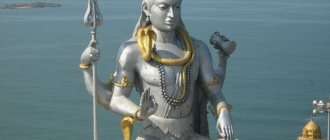Ganesha, or Ganapati (Sanskrit गणेश; Gaṇeśa IAST; pronunciation (inf.)) - is a deity responsible for wisdom and well-being. He is considered the most famous and revered god in the Hindu pantheon.
It is common to add to his name the prefix Sri-, as a symbol of special respect. The chanting of sahasranamas in honor of the deity (Sanskrit गणेश सहस्रनाम, "a thousand names of Ganesha") is often used as worship, each of these names highlighting some one aspect of the god (Ganapati-sukta).
Meaning
Ganesha is the god of luck. Among his names the best known are Ganapati, Vigneshwara, Vinayake, Pillayar, Binayak, etc.
The word "ganesha" itself includes two separate words: "gana" (group, unity of a multitude) and "isha" (god, teacher). The name "Ganapati" may also be decomposed into "gana" (some community) and "pati" (ruler).
Ganas were called demigods (gana-devatas), they were assistants of Shiva and were headed by Ganesha. All the demigods can be grouped into 9 classes: aditya, vishwadeva, vasu, tushita, abhasvara, anila, maharajika, sadhya, ruddra.
The very first mention of the name "Ganapati" is found in the Veda Hymns (2.23.1).

The Sanskrit lexical dictionary of terms Amarakosha (by the sage Amara Sinha) calls Ganesha by the following namesVignesha or Vignaraja, Vinayaka and Vigneshwara (the deliverer of obstacles), Dwaimatura (born of two mothers), Ganadhipa, Ekadanta (having one tusk), Cheramba, Lambodara and Mahodara (full belly), Gajanana (elephant-faced), Dhavalikar (quick to enter the pantheon of gods).
Vinayaka is also mentioned in the name of the eight Hindu temples of Ashtavinayak, Maharashtra. At these sacred sites, pilgrims from all over the world often gather to visit the temples in a particular order. All eight structures honoring Ganesha are located around the city of Pune. Each has its own legend and history. The form and manifestation of the deity in the temples also differs from each other.
Yatra (pilgrimage) is recommended in the following order:
- Mayureshwar in Morgaon;
- Siddhivinayak in Siddhathek ;
- Ballaleshwar in Pali;
- Varadavinayak in Mahad ;
- Chintamani in Theura;
- Girijatamaj at Lenyadri;
- Vighnahar in Ozar;
- Mahaganapati at Ranjangaon.
Elephant tattoo for a girl
Any kind of elephant on a girl's body can additionally be associated with independence and superiority over a man. This symbolism is associated with matriarchy in elephant herds. Male elephants are rarely the leaders. Usually closer to reaching puberty, males leave the herd and become outcasts. They have to live on their own, but during the mating season they approach females to mate.


For this reason, men stab elephants to show their lack of desire, without having to be in the company of females.


However, Christians use the image of the elephant to demonstrate the self-sacrifice of Jesus because he was able to overcome death. The latter is represented by the serpent under the feet of the giant. This version is usually considered good in the blasphemous world. In addition, it can mean a mysterious connection with higher forces.


This idea is considered a great option for both sexes. It was copied from the tenets of Hinduism, in which elephants are considered the pillars of the world, companions of Indra, god of the atmosphere.
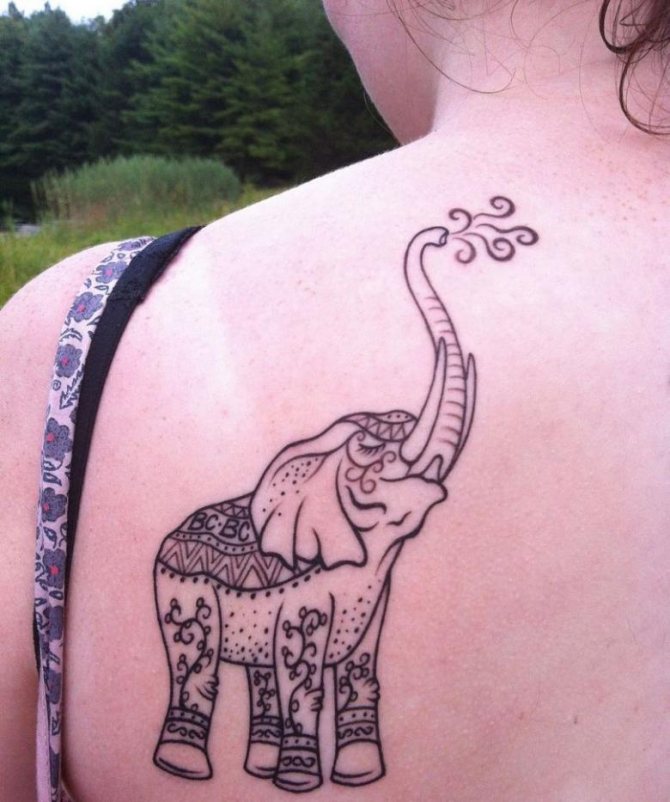

Image
The image of Ganesha is inextricably linked to a humanoid creature with an elephant's head and one tusk.. He usually has four arms.
The deity moves on a rat (vahana), which symbolizes sensual manifestations and selfish interests subordinate to Ganesha.
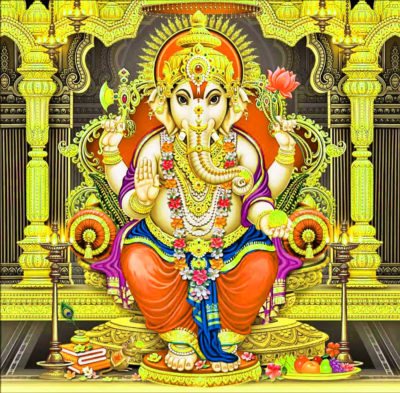

Why does the deity have an elephant-like face? The fact is that he lost his head after birth. God Shani (Saturn) wouldn't look at the child when he was born. This is due to a curse placed on him, which caused everything he looked at to become ashes. Goddess Parvati insisted that Shani look at the child and his head disappeared. God shiva started looking for a new head for his son. Brahma advised him to take it from the first creature he saw who slept with his head facing north. It turned out to be an elephant named Airavata, who is Indra's vahana.
One of Ganesha's tusks had been broken during a battle with the giant Gajamukha. When he touched the tusk, he was transformed into a rat (vahana) by an incredible force.
There is another legend that speaks of Ganesha's use of the tusk as a pen for writing Vyasa's Mahabharata.
Most often the deity has four hands clutching the following attributes:
- an axe (eliminating attachment to all material things, it is also a symbol of power);
- harness or hook (limiting and controlling one's selfish desires);
- trident (personification of power);
- lotus (symbol of spiritual enlightenment);
- a broken tusk in the lower right hand, but in some depictions its fingers are folded in a protective abhaya-mudra.
The number of hands can be more or less than four (from 2 to 16). Often in drawings you can see the deity dancing, which symbolizes prosperity and wisdom.
Legends
The legends of the elephant-like face of the god vary. Puranic texts, for example, have descriptions of the deity originally born with an elephant's head. Other legends tell of the acquisition of a new head after birth, and before that the deity looked like an ordinary human being.
The "Shiva Purana" tells us that Ganesha was born to Parvati as a gatekeeper for her own palace. She needed a guard during her ablutions so that no one could violate her privacy and enter her chambers. Legend has it that Ganesha emerged from Parvati's sweat. The deity's special qualities were his power and valor. Even Shiva could not approach his wife. He ordered the faithful Ganas to chase his son away from Parvati's chambers, but he fought bravely and was able to stand up to the warriors. This was a momentous battle for the Hindu pantheon, for. All the gods participated in it, along with Vishnu.
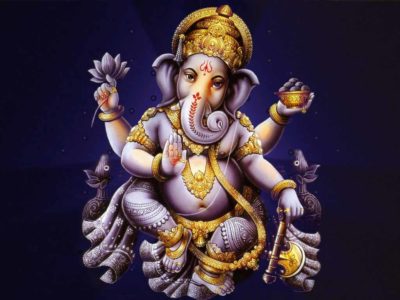

Ganesha did not give up. Then Shiva cut off his son's head with his own hands. Parvati was furious and wanted to bring down a flood on all those who fought her son. The gods, foreseeing the extent of the destruction, appealed to Parvati to stop. But the only thing in their power was to bring Ganesha back to life.
Shiva sent the gods in search of a new head for his son, commanding him to chop it off the first person he saw. It turned out to be an elephant. And the deity's broken tusk appeared already during the second incarnation, when he was called Ekadant (the legend from the Mudgala Purana).
Some drawings show a snake. It represents energetic transformation. "The Ganesha Purana describes the appearance of the snake as follows: it was wrapped around the neck of Ganesha by the gods and asuras when the Milky Ocean was plowing. The same legend refers to the drawing of the tilaka or crescent sign on Ganesha's forehead. In this case he is referred to as Bhalachandra, one of the 12 names of Ganesha.
Synopsis. Ocean churning is the process of churning the waters of the ocean for the purpose of extracting the drink of immortality amrita. There is no single list of treasures extracted from the ocean.
The vahana rat also did not appear by accident. The Mudgala Purana tells of four incarnations of the deity, in which he moved on different animals:
- A shrew;
- a lion (Vakratunda);
- A peacock (Vikatha);
- Sheshu the serpent (Vighnaraja);
- horse (Dhumravarnu).
The Ganesha Purana mentions other vahana deities:
- peacock (Mayureshwara);
- lion (Mahatkata-Vinayaki);;
- horse (Dhumraketa);
- the rat (Gajanana).
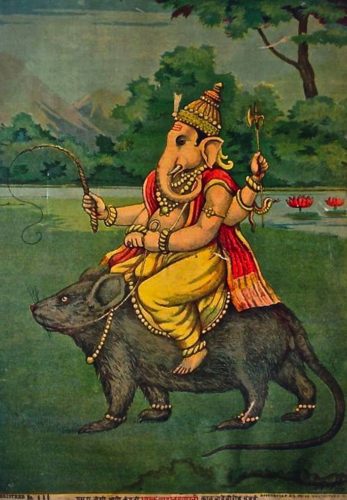

But it is the rat that is considered to be Ganesha's main means of transportation. This is because, according to Hindu canons, the mouse symbolizes the tamo-guna - desires, which must be restricted if one seeks spiritual self-development (getting rid of selfish manifestations). Ganesha, ruling the rat, copes with all difficulties on the Path of spiritual growth. In his other names (Vigneshvara, Vignaratha, Vignaraja) is hidden the power necessary for destroying obstacles. Though, he himself is the cause of their appearance. He is capable of giving lessons in the form of difficulties for spiritual growth. Overcoming them, a person becomes a step higher in self-improvement.
In the elephant form incorporated the strength and power of unruly, intractable creature. When the elephant is restrained by the ankus (the trainer's tool) and the rope, it means restraining one's feelings and the gross material aspects of personality. In this way one can remove the obstacles on the spiritual Path that arise due to selfish thoughts. At Ganesha's feet there is usually a cup with various sweets (modaks), a symbol of enlightenment, which the spiritual seeker longs for.
Legendary meditation course with no fee Recommended! The most popular meditation course for beginners in Russian. More than 100 thousand people have already learned to meditate. Try it for yourself. Learn more.
It's better to make offerings in an amount of 21 sweet balls (modaki), which are self-made. This is Ganesha's favorite number.
The iconography of Ganesha
There are different depictions of Ganesha. Sometimes he is drawn with a yellow body and in some cases with a red body. The deity has a large belly, 4 arms and a powerful elephant head with one tusk.
The belt god winds a snake, symbolizing energy, which can take many different forms.
In most paintings, Ganesha sits on a lotus flower. A mouse or rat (sometimes replaced by a shrew or dog) is always seen next to him. Legend has it that the good god subdued this creature, which previously had the soul of the devil. The animal, a symbol of vanity and impertinence, became so docile that it allowed itself to be ridden. Ganesha has been riding him ever since. And Indians believe that Sri Ganesha helps spiritual growth by getting rid of vanity, selfishness, and pride.
We've picked up some interesting articles for you:
The Yijing - the book of changes.
27.01.2019
Hieroglyphs according to feng shui
27.01.2019
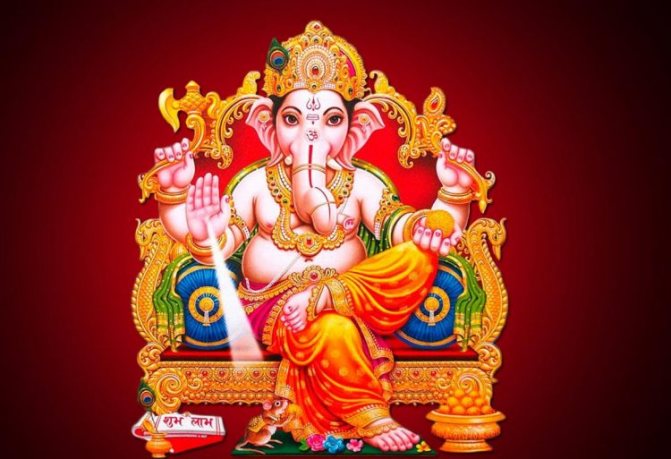

Ganapati has several hands. In different images, their number can be as many as 4, 6, 8, 18 or 32. At the same time in the upper extremities, he holds a lotus and trident. The fourth hand is arranged in such a way as to give the impression that it gives something to the one looking at the god. Sometimes it holds a lada, a sweet delicacy made of rice flour. Other hands of the deity may hold such objects:
- A harness, which helps to catch luck;
- an axe that cuts off all visible and invisible obstacles that lie in the way of the goal;
- a shell, which is a source of wisdom;
- a staff, which is a symbol of support, necessary for a person throughout his life;
- A bowl of abundance, which brings prosperity and good energy into the home;
- a tortilla, through which a person will be granted prosperity;
- The lotus flower, symbolizing the development of the spirit.
The trunk of the deity holds a candy. It is a symbol of happiness, which gives liberation from the influence of negative energies. Ganesha needs big elephant ears to make sure that he does not miss any requests for help that people send him in their prayers.
The Indian god of wisdom.
Sri Ganesha is an akasha-abhimani-devata, a deity who is able to control the secondary ether (bhuta-akasha) produced under the influence of the guna tamas. The five primary elements of creation are united in him, and he also becomes the cause of the birth of false egoistic manifestations. It is significantly influenced by the god Shiva. Most of all, hearing is interconnected with the secondary ether. With the help of the ears, one can perceive the sound vibrations that exist in the ether.
It should be recalled that Vedic knowledge was originally transmitted orally from generation to generation. Ganesha is also known as patron of knowledge (buddhi). The stories attribute to him high mental and intellectual abilities. One of the deity's names is translated as "lover of knowledge" (buddipriya), where "priya" means "loving" and "buddhi" means "knowledge". If Ganesha blesses, a person can move to a new stage of spiritual development.
There is a legend that the deity wrote down the text of the Mahabharata under the dictation of Vyasa, each verse of which has not only a direct meaning but also ten hidden meanings. Secret knowledge is accessible only to those who can comprehend Vedic truth.
The hidden meanings of Ganesha's body parts
Every part of the body of the immortal Ganapati has a meaning. The elephant's head represents the deity's inherent prudence, constancy and loyalty. The ears confirm the goodness of the spirit, symbolizing its infinite nobility and desire to help those in need.
Tusk symbolizes the focus on the fight, the desire to overcome the duality of human nature, to overcome its negative side, characterized by laziness, squabbling, malice and other destructive qualities.
A long trunk speaks of the deity's high intellectual abilities. A large belly was given to Ganesha as a sign of his generosity and magnanimity.
Ganesha talisman will be a protection and help to a person who wants to find confidence and happiness.
Family
Ganesha was born into the family Goddess Shiva and Goddess Parvati. But the story of his birth is very controversial in the Puranic myths. There is a version that the creator of the deity was Shiva, and in another version - Parvati. There is also the legend of Ganesha's inscrutable birth and his adoption by his new parents Shiva and Parvati.
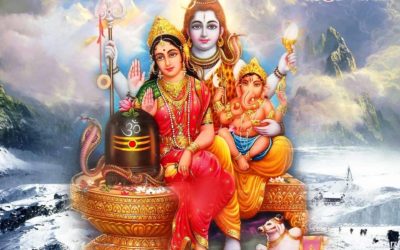

His brother is called Skanda (Kartikeya, Murugan). The northern part of India sees Skanda as the elder of the brothers, and the southern part sees Ganesha.
It is known about Skanda that he was a warrior deity and existed from the fifth century BC to the sixth century AD. When the worship of Skanda declined, the number of Ganesha worshippers sharply increased.
There is no consensus on the deity's family ties either. Some myths glorify Ganesha as a brahmacharya who cannot have a wife. This view is particularly prevalent in southern India and partly in northern India.
Another version states that Ganesha possessed the three ideas of buddhi (intelligence, reason), siddhi (success), and riddhi (prosperity). These same ideas correspond to the deity's wives of the same name.
A third version: the wife of Ganesha is. goddess Saraswati.The deity in charge of art and culture, or Lakshmi, in charge of good fortune and prosperity.
What is this deity?
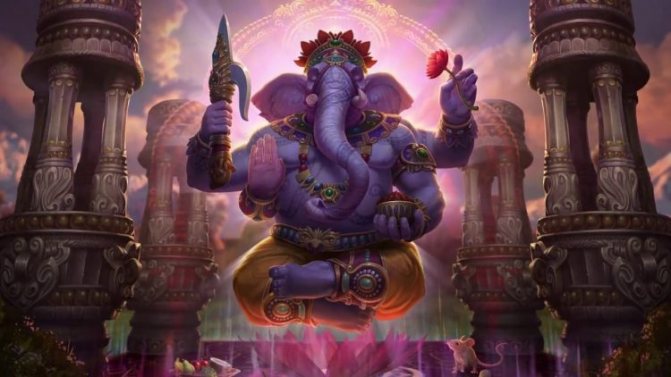

The deity Ganesha, otherwise known as Ganapati, is easy to remember because of his extraordinary appearance. He has the body of a man and the head of an elephant. Ganesha is considered to be the patron of those people who lead righteous lives, do not forget to pray and have bright thoughts. On such people he directs all his kindness and benevolence.
In the homeland of Ganapati, the god of prosperity and wisdom is among the spirits that are especially revered by Indians. They show their respect by adding the prefix Sri to the deity's name. The dancing Ganesha is the son of the supreme god Shiva and his consort, the daughter of the king of the mountains, Parvati. The spouses of Ganesha are two goddesses: Buddhi, who rules the mind, and Siddhi, who rules success.
The trunk of Ganapati is endowed with extraordinary power, through which the deity can remove any obstacles, clearing the way for whoever wants to reach the top in any matter.
Yantra


Yantra Ganesha is depicted in the form of a geometric structure, which is able to radiate a special protective energy. Yantra helps to remove any obstacles to spiritual and personal development. It is best to place it in the north-eastern part of your dwelling. Before beginning of affairs it is necessary to address to this yantra with pure intentions. Then everything will turn out well and help from Ganesha will come in the form of elimination of possible barriers.
Mudra
Those who master how to do this mudra, the god Ganesha will give self-confidence and courage. Performing the mudra opens the bronchi, improves cardiac activity, strengthens the muscles of the heart and removes distortions of energy in the area of these organs, affecting the 4th chakra.
The exercise is performed as follows:
- The left hand is placed in front of the chest. The inner side of the palm should be turned outward.
- Bend the fingers of the left hand.
- The right hand is placed with the back side outward and interlock the fingers with the left hand.
- Hands are lowered to the level of the heart.
- Breathe in and simultaneously with an effort, without loosening the fingers, pull both hands apart. You will feel a tension in the muscles of the chest and upper arms.
- Breathing out, relax the muscles.
- Repeat the exercise 6 times and then put your hands on your chest, as if running the energy of love into your heart and concentrating on your sensations.
- Change the position of the hands and repeat the exercise 6 times.
After doing the exercise, you need to be alone for a while. Repeat the mudra once a day.
Mantras
In today's world, people often turn to Ganesha to improve their financial well-being. There is a lot of information on the internet that all it takes is to chant a mantra in honor of the deity and money will start coming into the wallet for nothing. But this is not a reasonable approach. That is no way to address the gods. It is important to remember that everyone has in this life exactly as much as he really needs to help the living beings around him. There should be no selfish, self-serving thoughts while addressing the god. When the heart radiates the energy of love, kindness, purity and sincerity, only then will the gods hear and grant mercy.
Ganesha is able to help those who have pure intentions. To address him, one should recite the mantras:
"Om Gam Ganapataye namaha."
"Om Kshipra Prasadaya Namaha."
In the last mantra, the word "Kshipra" translates to "instantly." This mantra will help to find a way out of an emergency situation, in case of danger or negative energy to a person. During its pronunciation, there is a blessing and deliverance from negative vibrations in the personal energy space.
Ganesha in the teachings of Feng Shui
Many people are confused by the unusual appearance of the Indian god Ganapati, and they do not want to put his image at home. But only a subtle mind will be able to discern behind the strangeness of his appearance a soul that is full of kindness and sincere generosity. Only the person who renounces stereotypes in thinking can find spiritual freedom, confidence and harmony in himself.
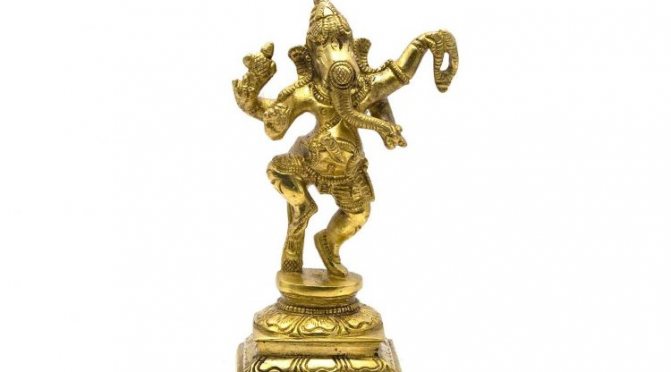

God Ganapati can be an effective amulet in many matters. A statue of the deity with the head of an elephant is installed in the home, in the office. It can be worn on the arm or neck. The image of the spirit to attract material wealth is placed in a purse.
It is common thought that the bigger the figure of Ganesha, the higher the probability to achieve success. However, there is no confirmation of this fact in the Chinese teachings.
If the statuette for some unknown reason suddenly breaks off some part, for example, an arm or a tusk, or the base itself is cracked, it is a sure sign that the deity has protected the owner of the house from some great danger. There is no need to get rid of such a talisman. It is necessary to try to attach a broken off part to a former place, accompanying the process with words of sincere gratitude. Then the deity will restore its state and will be able to continue to protect the person who seeks its patronage.
A bronze statue of Ganesha is better placed in the west or northwest sector. A good place for it would be the right side of the desk. A figurine of wood will strengthen relationships in the family, so the best place for it would be the south-eastern or eastern sector.
It is not enough to put the Indian deity in the right direction. Ganesha needs constant attention: you need to talk to him, rub his belly and palms. The mantra to the god with the elephant's head can be chanted to increase the intensity of energy flows in any sector. You can win his favor with sweets, which should be placed on a saucer in front of the statuette.
Techniques and places of application
The image of Ganesha is suitable for any technique of application: whether it is a black and white tattoo that looks solid and serious, or a colored tattoo without color restrictions. But the main thing is that the tattoo should be dominated by a distinctive ethnic style, specific to ancient Indian drawings, murals, bas-reliefs. But it is also possible to use such styles as:
- NewSchool;
- DotWork;
- Graphics;
- Surrealism.


It is possible to use a combination of these styles with Indian ornaments, mandalas and other ethnic motifs.


Very popular are sketches of Gapanati sitting in an asana pose (crossed legs), but also found dancing or a god saddled with a rat.


The tattoo is characterized by an abundance of small details, so it is worth applying Ganesha on the back or chest and stomach, but it is also possible on the arm and thigh. However, you should not tattoo the god in the intimate areas, on the ankles and lower back. This is considered unacceptable sacrilege.


It is worth remembering that the deity of wisdom will not help, hungry for other people's treasures, or people with an "unclean" soul.
Sketches.
Sketches of the elephant tattoo in the style of realism are especially popular. Many people score a large tattoo with the image of an elephant with its typical coloring. An alternative to this option is the tattoo of a rare white elephant, which is especially valued in Asian countries. Such a tattoo denotes spirituality and knowledge. Black and white designs are also popular.
You can score a more positive image of a multicolored animal decorated with flowers and jewels. This is how the sacred elephant is depicted in Asian countries. Multicolor tattoo is relevant to followers of Buddhism and simply connoisseurs of the rich Asian culture.

